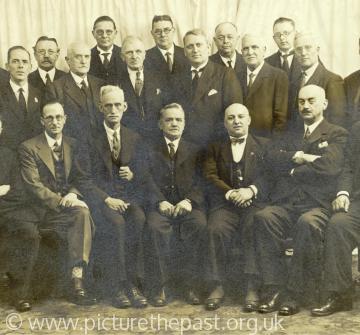Government and Administration
 Members and officers of Bolsover Urban District Council, photographed in the 1920s or 30s
Members and officers of Bolsover Urban District Council, photographed in the 1920s or 30sGovernment has traditionally been split between the activities of central government (Westminster) and local government (the manor, the parish, the borough, and the county). Westminster needed to exercise governmental powers over the country both to maintain control (law and order), and also to raise taxation to support the activities of central government (particularly war and foreign conflict). It exercised authority in the localities through its officers: the custos rotulorum was in charge of civil affairs, and usually held the post consecutively with the position of lord lieutenant whose responsibilities included the raising of troops; and the high constable(s). The county’s powers were exercised by Justices of the Peace sitting in Quarter Sessions (which was responsible for both law enforcement through the courts and county business such as the upkeep of bridges and gaols) until 1888-9 when County Councils were established.
The parish had various government functions in regard both to ecclesiastical matters, through the churchwardens, and civil issues, through the constable, and the overseers of the poor and of the highways. Boroughs were towns which had a charter, or charters, granting them rights to incorporation, or self-government on lines similar to those of counties, including their own government (mayor, aldermen and councillors), legal authority (through Quarter Sessions), and taxation. Most, but not all boroughs, also returned two MPs to Parliament (prior to the reforms of 1832-1885). Borough status was remodelled in 1835. Cities are towns with borough status and an Anglican cathedral (to 1889) or major places recognised as cities for their wealth and industrial capacity. Numerous changes in local government took place during the twentieth century, and the basic structure in 2010 is between counties, boroughs, and parishes.






